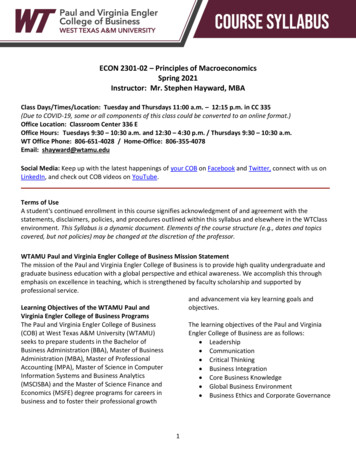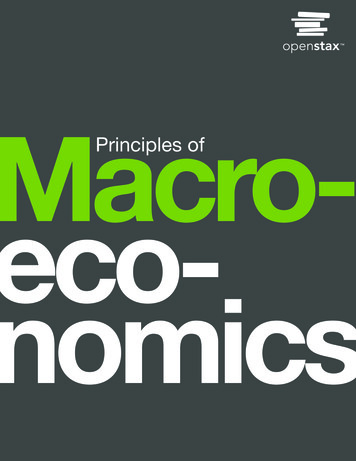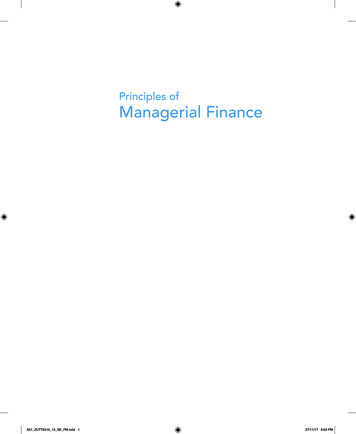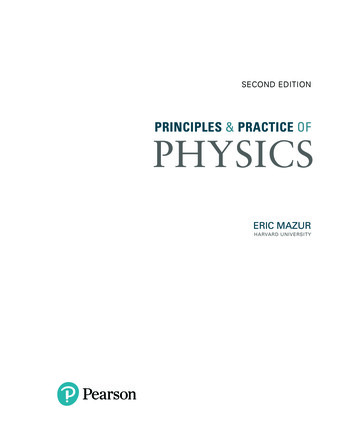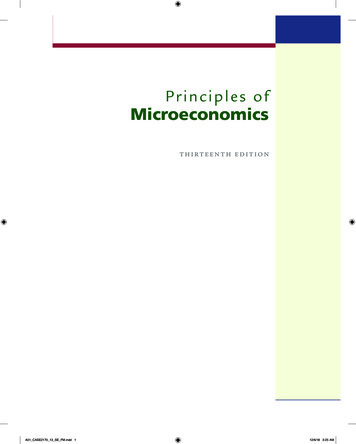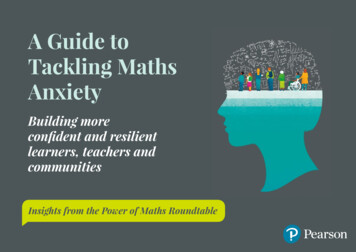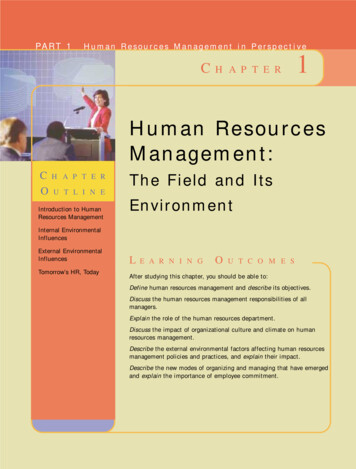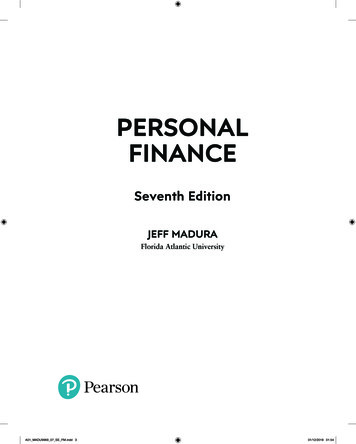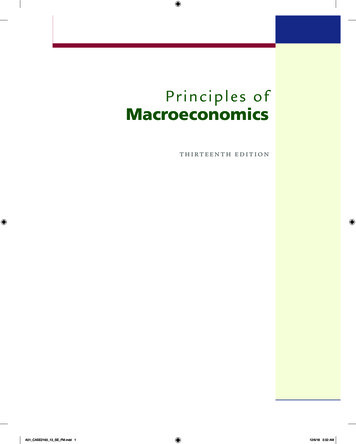
Transcription
Pr inciples ofMacroeconomicsTHIRTEENTH EDITIONA01 CASE2163 13 SE FM.indd 112/6/18 3:32 AM
A01 CASE2163 13 SE FM.indd 212/6/18 3:32 AM
Pr inciples ofMacroeconomicsKarl E. CaseWellesley CollegeRay C. FairYale UniversitySharon M. OsterYale UniversityTHIRTEENTH EDITIONA01 CASE2163 13 SE FM.indd 312/6/18 3:32 AM
Vice President, Business, Economics, and UKCourseware: Donna BattistaDirector of Portfolio Management: AdrienneD’AmbrosioSpecialist Portfolio Manager: David AlexanderEditorial Assistant: Nicole NedwidekVice President, Product Marketing: Roxanne McCarleySenior Product Marketer: Carlie MarvelProduct Marketing Assistant: Marianela SilvestriManager of Field Marketing, Business Publishing:Adam GoldsteinField Marketing Manager: Ashley BryanVice President, Production and Digital Studio, Artsand Business: Etain O'DeaDirector, Production and Digital Studio, Businessand Economics: Ashley SantoraManaging Producer, Business: Alison KalilContent Producer: Carolyn PhilipsOperations Specialist: Carol MelvilleDesign Lead: Kathryn FootManager, Learning Tools: Brian SuretteSenior Learning Tools Strategist: Emily BibergerManaging Producer, Digital Studio and GLP: JamesBatemanManaging Producer, Digital Studio: Diane LombardoDigital Studio Producer: Melissa HonigDigital Studio Producer: Alana ColesDigital Content Team Lead: Noel LotzDigital Content Project Lead: Noel LotzFull Service Project Management: Jennifer Gavigan,Integra Software ServicesInterior Design: Integra Software Services, Inc.Cover Design: Integra Software Services, Inc.Cover Art: Integra Software Services, Inc.Printer/Binder: LSC Communications, Inc.Cover Printer: LSC Communications, Inc.Copyright 2020, 2017, 2014 by Pearson Education, Inc. or its affiliates. All Rights Reserved. Manufacturedin the United States of America. This publication is protected by copyright, and permission should be obtained fromthe publisher prior to any prohibited reproduction, storage in a retrieval system, or transmission in any form or by anymeans, electronic, mechanical, photocopying, recording, or otherwise. For information regarding permissions, requestforms, and the appropriate contacts within the Pearson Education Global Rights and Permissions department, pleasevisit www.pearsoned.com/permissions/.Acknowledgments of third-party content appear on page 443, which constitutes an extension of this copyright page.PEARSON, ALWAYS LEARNING, and MYLAB are exclusive trademarks owned by Pearson Education, Inc. or its affiliates in the U.S. and/or other countries.Unless otherwise indicated herein, any third-party trademarks, logos, or icons that may appear in this work are theproperty of their respective owners, and any references to third-party trademarks, logos, icons, or other trade dress arefor demonstrative or descriptive purposes only. Such references are not intended to imply any sponsorship, endorsement, authorization, or promotion of Pearson’s products by the owners of such marks, or any relationship between theowner and Pearson Education, Inc., or its affiliates, authors, licensees, or distributors.Library of Congress Cataloging-in-Publication DataNames: Case, Karl E., author. Fair, Ray C., author. Oster, Sharon M.,author.Title: Principles of macroeconomics / [Karl E. Case, Ray C. Fair, Sharon M. Oster].Description: [13th edition]. Upper Saddle River, NJ : Pearson, [2019] Includes index.Identifiers: LCCN 2018018216 ISBN 9780135162163 (softcover)Subjects: LCSH: Macroeconomics.Classification: LCC HB172.5 .C375 2019 DDC 339—dc23LC record available at https://lccn.loc.gov/201801821610 9 8 7 6 5 4 3 2 1ISBN 10:0-13-516216-5ISBN 13: 978-0-13-516216-3A01 CASE2163 13 SE FM.indd 412/6/18 3:32 AM
This edition is dedicated to Chip Case, a wonderful colleague and friend. He was the inspiration for this textbooksome 30 years ago, and he served as an inspiration to study economics for thousands of students.A01 CASE2163 13 SE FM.indd 512/6/18 3:32 AM
About the AuthorsKarl E. Case, who passed away in July, 2016, was a Professor of Economics Emeritus at WellesleyCollege where he taught for 34 years, serving several tours of duty as Department Chair. He wasa Senior Fellow at the Joint Center for Housing Studies at Harvard University and a founding partner in the real estate research firm of Fiserv Case Shiller Weiss, which produces the S&P CaseShiller Index of home prices. He served as a member of the Index Advisory Committee of Standard and Poor’s, and on the Academic Advisory Board of the Federal Reserve Bank of Boston.Professor Case received his B.A. from Miami University in 1968, spent three years on activeduty in the Army, and received his Ph.D. in Economics from Harvard University in 1976.Professor Case’s research was in the areas of real estate, housing, and public finance. Heauthored or coauthored five books, including Principles of Economics, Economics and Tax Policy, andProperty Taxation: The Need for Reform, and published numerous articles in professional journals,focused on real estate markets and prices.Chip, as he was known to his many friends and colleagues, contributed to this textbookthroughout its many editions. In his honor and with respect for his substantial contributions tothe text and the discipline of economics, his co-authors plan to keep his name on the text for allfuture editions.Ray C. Fair is Professor of Economics at Yale University. He is a member of the Cowles Foundation at Yale and a Fellow of the Econometric Society. He received a B.A. in Economicsfrom Fresno State College in 1964 and a Ph.D. in Economics from MIT in 1968. He taught atPrinceton University from 1968 to 1974. Professor Fair has taught introductory and intermediate macroeconomics at Yale since 1974. He has also taught graduate courses in macroeconomictheory and macroeconometrics.Professor Fair’s research has primarily been in the areas of macroeconomics and econometrics, with particular emphasis on macroeconometric model building. He has alsodone work in the areas of finance, voting behavior, and aging in sports. His publications include Specification, Estimation, and Analysis of Macroeconometric Models (Harvard Press, 1984); Testing Macroeconometric Models (Harvard Press, 1994); Estimating How the Macroeconomy Works (HarvardPress, 2004), and Predicting Presidential Elections and Other Things (Stanford University Press, 2012).Professor Fair’s U.S. and multicountry models are available for use on the Internet free ofcharge. The address is http://fairmodel.econ.yale.edu. Many teachers have found that havingstudents work with the U.S. model on the Internet is a useful complement to an introductorymacroeconomics course.Sharon M. Oster is the Frederic Wolfe Professor of Economics and Management and formerDean of the Yale School of Management. Professor Oster joined Case and Fair as a coauthor in theninth edition of this book. Professor Oster has a B.A. in Economics from Hofstra University anda Ph.D. in Economics from Harvard University.Professor Oster’s research is in the area of industrial organization. She has worked on problems of diffusion of innovation in a number of different industries, on the effect of regulations onbusiness, and on competitive strategy. She has published a number of articles in these areas andis the author of several books, including Modern Competitive Analysis and The Strategic Managementof Nonprofits.Prior to joining the School of Management at Yale, Professor Oster taught for a number ofyears in Yale’s Department of Economics. In the department, Professor Oster taught introductory and intermediate microeconomics to undergraduates as well as several graduate coursesin industrial organization. Since 1982, Professor Oster has taught primarily in the ManagementSchool, where she teaches the core microeconomics class for MBA students and a course in thearea of competitive strategy. Professor Oster also consults widely for businesses and nonprofitorganizations and has served on the boards of several publicly traded companies and nonprofitorganizations.viA01 CASE2163 13 SE FM.indd 612/6/18 3:32 AM
Brief ContentsPART I Introduction to Economics11 The Scope and Method of Economics 12 The Economic Problem: Scarcity and Choice 23PART II74 oncepts and ProblemsCin Macroeconomics 925 Introduction to Macroeconomics 926 Measuring National Output and NationalIncome 1057 Unemployment, Inflation, and Long-RunGrowth 125PART III he Core of MacroeconomicTTheory 1418 Aggregate Expenditure and EquilibriumOutput 1439 The Government and Fiscal Policy13 The Labor Market in the Macroeconomy16410 Money, the Federal Reserve, and the InterestRate 19011 The Determination of Aggregate Output, the PriceLevel, and the Interest Rate 217247 Further MacroeconomicsIssues 266PART IV3 Demand, Supply, and MarketEquilibrium 434 Demand and Supply Applications12 Policy Effects and Cost Shocks in the AS/ADModel 23414 Financial Crises, Stabilization, and Deficits26615 Household and Firm Behavior in theMacroeconomy: A Further Look 28216 Long-Run Growth 30317 Alternative Views in MacroeconomicsPART V319The World Economy 33518 International Trade, Comparative Advantage, andProtectionism 33519 Open-Economy Macroeconomics: The Balance ofPayments and Exchange Rates 35920 Economic Growth in Developing EconomiesPART VIMethodology38540221 Critical Thinking about Research 402GlossaryIndex417427Photo Credits443viiA01 CASE2163 13 SE FM.indd 712/6/18 3:32 AM
ContentsPART I Introduction to Economics 11The Scope and Methodof Economics 112 Review Terms and Concepts13Problems 13 Appendix: How to Read and Understand Graphs 15238Summary 38 Review Terms and Concepts 39 Problems 39Why Study Economics? 2To Learn a Way of Thinking 2ECONOMICS IN PRACTICE Rainfall and Schoolingin India 3ECONOMICS IN PRACTICE Majoring in EconomicsMakes You Less Vulnerable to a Recession! 4To Understand Society 4To Be an Informed Citizen 5The Scope of Economics 5Microeconomics and Macroeconomics 5ECONOMICS IN PRACTICE iPod and the World 6The Diverse Fields of Economics 7The Method of Economics 8Theories and Models 8ECONOMICS IN PRACTICE Does Your RoommateMatter for Your Grades? 10Economic Policy 10An Invitation 12Economic Skills and Economics as a Career 12SummaryMixed Systems, Markets, and GovernmentsLooking Ahead 38The Economic Problem: Scarcityand Choice 23Scarcity, Choice, and Opportunity Cost 24Scarcity and Choice in a One-PersonEconomy 24Scarcity and Choice in an Economy of Two orMore 25ECONOMICS IN PRACTICE Frozen Foods andOpportunity Costs 26The Production Possibility Frontier 29The Economic Problem 35ECONOMICS IN PRACTICE Trade-Offs among theRich and Poor 36Economic Systems and the Roleof Government 36Command Economies 36Laissez-Faire Economies: The Free Market 373Demand, Supply, and MarketEquilibrium 43Firms and Households: The BasicDecision-Making Units 44Input Markets and Output Markets: The CircularFlow 44Demand in Product/Output Markets 46Changes in Quantity Demanded versus Changesin Demand 46Price and Quantity Demanded: The Lawof Demand 47Other Determinants of Household Demand 50ECONOMICS IN PRACTICE Have You Bought ThisTextbook? 51ECONOMICS IN PRACTICE On Sunny Days PeopleBuy Convertibles! 52Shift of Demand versus Movement alonga Demand Curve 53From Household Demand to Market Demand 54Supply in Product/Output Markets 56Price and Quantity Supplied: The Law of Supply 57Other Determinants of Supply 58Shift of Supply versus Movement along a SupplyCurve 59From Individual Supply to Market Supply 60Market Equilibrium 61Excess Demand 61Excess Supply 63Market Equilibrium with Equations 64Changes in Equilibrium 64ECONOMICS IN PRACTICE Quinoa 67Demand and Supply in Product Markets:A Review 67ECONOMICS IN PRACTICE Why Do the Pricesof Newspapers Rise? 68Looking Ahead: Markets and the Allocationof Resources 69Summary 69 Review Terms and Concepts 70 Problems 71viiiA01 CASE2163 13 SE FM.indd 812/6/18 3:32 AM
Contents4Demand and SupplyApplications 74The Price System: Rationing and AllocatingResources 75Price Rationing 75Constraints on the Market and AlternativeRationing Mechanisms 77ECONOMICS IN PRACTICE Why is My Hotel RoomSo Expensive? A Tale of Hurricane Sandy 79Prices and the Allocation of Resources 81Price Floor 81Supply and Demand Analysis: Tariffs (Tax) 82ECONOMICS IN PRACTICE The Price Mechanismat Work for Shakespeare 83Supply and Demand and Market Efficiency 84Consumer Surplus 84Producer Surplus 85Competitive Markets Maximize the Sumof Producer and Consumer Surplus 86Potential Causes of Deadweight Loss FromUnder- and Overproduction 87Looking Ahead 88Summary 88 Review Terms and Concepts 88 Problems 89PART II Concepts and Problems inMacroeconomics592Introduction toMacroeconomics92Macroeconomic Concerns 93Output Growth 93Unemployment 95Inflation and Deflation 95The Components of the Macroeconomy 96The Circular Flow Diagram 96The Three Market Arenas 97The Role of the Government inthe Macroeconomy 98A Brief History of Macroeconomics 99ECONOMICS IN PRACTICE Macroeconomics inLiterature 100The U.S. Economy Since 1970 101Summary 103 Review Terms and Concepts 103 Problems 1036Measuring National Outputand National Income 105Gross Domestic Product 106Final Goods and Services 106A01 CASE2163 13 SE FM.indd 9ixExclusion of Used Goods and PaperTransactions 107Exclusion of Output Produced Abroadby Domestically Owned Factors ofProduction 107Calculating GDP 108The Expenditure Approach 108ECONOMICS IN PRACTICE Where Does eBay GetCounted? 109ECONOMICS IN PRACTICE EstimatingDepreciation in the National Income and ProductAccounts 111The Income Approach 112Nominal Versus Real GDP 114ECONOMICS IN PRACTICE GDP: One of the GreatInventions of the 20th Century 115Calculating Real GDP 116Calculating the GDP Deflator 117The Problems of Fixed Weights 118Limitations of the GDP Concept 118GDP and Social Welfare 118The Informal Economy 119ECONOMICS IN PRACTICE Green Accounting 119Gross National Income per Capita 120Looking Ahead 121Summary 121 Review Terms and Concepts 122 Problems 1227Unemployment, Inflation, andLong-Run Growth 125Unemployment 126Measuring Unemployment 126ECONOMICS IN PRACTICE Time Use for theUnemployed in a Recession 127Components of the Unemployment Rate 128ECONOMICS IN PRACTICE A Quiet Revolution:Women Join the Labor Force 129The Costs of Unemployment 129ECONOMICS IN PRACTICE The Consequencesof Unemployment Persist 130Inflation and Deflation 131The Consumer Price Index 131The Costs of Inflation 133What about Deflation? 135ECONOMICS IN PRACTICE Chain-Linked ConsumerPrice Index in the News 135Long-run Growth 136Output and Productivity Growth 136Looking Ahead 138Summary 138 Review Terms and Concepts 138 Problems 13912/6/18 3:32 AM
xContentsPART III The Core of MacroeconomicTheory8141Aggregate Expenditure andEquilibrium Output 143The Keynesian Theory of Consumption 144ECONOMICS IN PRACTICE Behavioral Biases inSaving Behavior 148Other Determinants of Consumption 148Planned Investment (I) versus ActualInvestment 149Planned Investment and the Interest Rate (r) 149Other Determinants of Planned Investment 150The Determination of Equilibrium Output(Income) 150The Saving/Investment Approach to Equilibrium 153Adjustment to Equilibrium 154The Multiplier 154ECONOMICS IN PRACTICE General Motors’Silverado 155The Multiplier Equation 157ECONOMICS IN PRACTICE The Paradox ofThrift 158The Size of the Multiplier in the Real World 180Looking Ahead 159Summary 160 Review Terms and Concepts 160 Problems 160Appendix9163The Government and FiscalPolicy 164Government in the Economy 165Government Purchases (G), Net Taxes (T),and Disposable Income (Yd) 165The Determination of Equilibrium Output(Income) 167Fiscal Policy at Work: Multiplier Effects 169The Government Spending Multiplier 169The Tax Multiplier 172The Balanced-Budget Multiplier 173The Federal Budget 175The Budget in 2017 175Fiscal Policy since 1993: The Clinton, Bush, Obama,and Trump Administrations 176ECONOMICS IN PRACTICE Long-TermProjections of the Federal Government Deficit andDebt 178The Federal Government Debt 179The Economy’s Influence on the GovernmentBudget 180A01 CASE2163 13 SE FM.indd 10Automatic Stabilizers and DestabilizersFull-Employment Budget 181Looking Ahead 181Summary181 Review Terms and ConceptsProblems182 EOC Questions 184 Appendix AAppendix B180182185186 Appendix Summary 189Appendix Problems 18910Money, the Federal Reserve,and the Interest Rate 190An Overview of Money 191What Is Money? 191ECONOMICS IN PRACTICE Don’t Kill theBirds! 192Commodity and Fiat Monies 192Measuring the Supply of Money in the UnitedStates 193How Banks Create Money 195A Historical Perspective: Goldsmiths 195ECONOMICS IN PRACTICE A Run on the Bank:George Bailey, Mary Poppins, Wyatt Earp 196The Modern Banking System 197The Creation of Money 198The Money Multiplier 200The Federal Reserve System 201Functions of the Federal Reserve 202The Demand for Money 203Interest Rates and Security Prices 204ECONOMICS IN PRACTICE Professor SerebryakovMakes an Economic Error 205How the Federal Reserve Controls the InterestRate 206Tools Prior to 2008 206Expanded Fed Activities Beginning in 2008 207The Federal Reserve Balance Sheet 208Tools After 2008 209Looking Ahead 210Summary 210 Review Terms and Concepts 211 Problems 211Appendix11214 Appendix Problems 216The Determination of Aggregate Output, the PriceLevel, and the InterestRate 217The Aggregate Supply (AS) Curve 218Aggregate Supply in the Short Run 218Shifts of the Short-Run Aggregate Supply Curve 220The Aggregate Demand (AD) Curve 22112/6/18 3:32 AM
xiContentsPlanned Aggregate Expenditure and the InterestRate 221The Behavior of the Fed 222ECONOMICS IN PRACTICE The Fed Gets a NewChair, Jerome Powell 224Deriving the AD Curve 225ECONOMICS IN PRACTICE How Does the Fed Lookat Inflation? 226The Final Equilibrium 227Other Reasons for a Downward-Sloping ADCurve 228The Long Run AS Curve 228Potential GDP 229ECONOMICS IN PRACTICE The Simple “Keynesian”Aggregate Supply Curve 230Summary 231 Review Terms and Concepts 231 Problems 23112Policy Effects and Cost Shocksin the AS/AD Model 234Fiscal Policy Effects 235Fiscal Policy Effects in the Long Run 236Monetary Policy Effects 237The Fed’s Response to the Z Factors 237Shape of the AD Curve When the Fed Cares MoreAbout the Price Level than Output 237What Happens When There Is a Zero InterestRate Bound? 238Shocks to the System 239Cost Shocks 239ECONOMICS IN PRACTICE A Bad Monsoon SeasonFuels Indian Inflation 240Demand-Side Shocks 241Expectations 241Monetary Policy Since 1970 242Inflation Targeting 243Looking Ahead 244Summary 244 Review Terms and Concepts 244 Problems 24413The Labor Market in the Macroeconomy 247The Labor Market: Basic Concepts 248The Classical View of the Labor Market 248The Classical Labor Market and the Aggregate Supply Curve 250The Unemployment Rate and the ClassicalView 250Explaining the Existence of Unemployment 250Efficiency Wage Theory 251A01 CASE2163 13 SE FM.indd 11Imperfect Information 251Minimum Wage Laws 251Explaining the Existence of CyclicalUnemployment 252Sticky Wages 252ECONOMICS IN PRACTICE Evidence on StickyWages 253ECONOMICS IN PRACTICE The Longer You AreUnemployed, the Harder It Is to Get a Job 254An Open Question 254The Short-run Relationship Between theUnemployment Rate and Inflation 255The Phillips Curve: A Historical Perspective 256Aggregate Supply and Aggregate Demand Analysisand the Phillips Curve 258Expectations and the Phillips Curve 259Inflation and Aggregate Demand 259The Long-run Aggregate Supply Curve, PotentialOutput, and the Natural Rateof Unemployment 260The Nonaccelerating Inflation Rateof Unemployment (NAIRU) 261Looking Ahead 262Summary 262 Review Terms and Concepts 263 Problems 263PART IV Further Macroeconomics Issues 26614Financial Crises, Stabilization,and Deficits 266The Stock Market, the Housing Market, andFinancial Crises 267Stocks and Bonds 267Determining the Price of a Stock 267The Stock Market Since 1948 269Housing Prices Since 1952 270Household Wealth Effects on the Economy 271Financial Crises and the 2008 Bailout 271ECONOMICS IN PRACTICE PredictingRecessions 272Time Lags Regarding Monetary and FiscalPolicy 273Recognition Lags 275Implementation Lags 275Response Lags 276Summary 277Government Deficit Issues 277Deficit Targeting 277Summary 279 Review Terms and Concepts 280 Problems 28012/6/18 3:32 AM
xiiContents15Household and Firm Behavior inthe Macroeconomy: A FurtherLook 282Households: Consumption and Labor SupplyDecisions 283The Life-Cycle Theory of Consumption 283The Labor Supply Decision 284Interest Rate Effects on Consumption 286Government Effects on Consumption and LaborSupply: Taxes and Transfers 286A Possible Employment Constraint on Households 287A Summary of Household Behavior 288The Household Sector Since 1970 288ECONOMICS IN PRACTICE Measuring HousingPrice Changes 289Firms: Investment and Employment Decisions 291Expectations and Animal Spirits 291Excess Labor and Excess Capital Effects 292Inventory Investment 293A Summary of Firm Behavior 294The Firm Sector Since 1970 294Productivity and the Business Cycle 296The Short-Run Relationship Between Outputand Unemployment 297The Size of the Multiplier 298ECONOMICS IN PRACTICE Estimating Multipliers:the Mafia Link 299Growth and the Environment and Issuesof Sustainability 313Summary 315 Review Terms and Concepts 315 Problems 31617Alternative Viewsin Macroeconomics319Keynesian Economics 320Monetarism 320The Velocity of Money 320The Quantity Theory of Money 321The Keynesian/Monetarist Debate 322Supply-Side Economics 323The Laffer Curve 323Evaluating Supply-Side Economics 324New Classical Macroeconomics 325The Development of New ClassicalMacroeconomics 325Rational Expectations 326ECONOMICS IN PRACTICE How Are ExpectationsFormed? 327Real Business Cycle Theory and New KeynesianEconomics 328Evaluating the Rational ExpectationsAssumption 329Behavioral Macroeconomics 330Testing Alternative MacroeconomicModels 330Summary 331 Review Terms and Concepts 332 Problems 332Summary 299 Review Terms and Concepts 301 Problems 30116Long-Run Growth303The Growth Process: From Agricultureto Industry 304Sources of Economic Growth 305Increase in Labor Supply 305ECONOMICS IN PRACTICE Government Strategyfor Growth 306Increase in Physical Capital 307Increase in the Quality of the Labor Supply(Human Capital) 309Increase in the Quality of Capital (EmbodiedTechnical Change) 309ECONOMICS IN PRACTICE German Jewish ÉmigrésContribute to U.S. Growth 310Disembodied Technical Change 310More on Technical Change 311U.S. Labor Productivity: 1952 I–2017 IV 312A01 CASE2163 13 SE FM.indd 12PART V The World Economy 33518International Trade,Comparative Advantage,and Protectionism 335Trade Surpluses and Deficits 336The Economic Basis for Trade: ComparativeAdvantage 336Absolute Advantage versus ComparativeAdvantage 337Terms of Trade 341Exchange Rates 342The Sources of Comparative Advantage 344The Heckscher-Ohlin Theorem 344Other Explanations for Observed TradeFlows 345Trade Barriers: Tariffs, Export Subsidies,and Quotas 34512/6/18 3:32 AM
ContentsECONOMICS IN PRACTICE Globalization ImprovesFirm Productivity 346U.S. Trade Policies, GATT, and the WTO 347ECONOMICS IN PRACTICE What Happens WhenWe Lift a Quota? 347Free Trade or Protection? 349The Case for Free Trade 349The Case for Protection 351ECONOMICS IN PRACTICE A Petition 353An Economic Consensus 355Summary 355 Review Terms and Concepts 356 Problems 35619Open-Economy Macroeconomics:The Balance of Payments andExchange Rates 359The Balance of Payments 360The Current Account 360The Financial Account 362ECONOMICS IN PRACTICE Who Are the DebtorNations? 363Equilibrium Output (Income) in an OpenEconomy 363The International Sector and Planned AggregateExpenditure 363Imports, Exports, and the Trade FeedbackEffect 366Import and Export Prices and the Price FeedbackEffect 366The Open Economy with Flexible ExchangeRates 367The Market for Foreign Exchange 368Factors That Affect Exchange Rates 371The Effects of Exchange Rates on theEconomy 373An Interdependent World Economy 376Summary 376 Review Terms and Concepts 377 Problems 377Appendix 379 Appendix Summary20384 Appendix Problems 384Economic Growth in DevelopingEconomies 385Life in the Developing Nations: Populationand Poverty 386ECONOMICS IN PRACTICE What Can We Learnfrom the Height of Children? 387A01 CASE2163 13 SE FM.indd 13xiiiEconomic Development: Sourcesand Strategies 387The Sources of Economic Development 388ECONOMICS IN PRACTICE Corruption 390Strategies for Economic Development 391ECONOMICS IN PRACTICE Who You Marry MayDepend on the Rain 393Two Examples of Development: Chinaand India 395ECONOMICS IN PRACTICE Cell Phones IncreaseProfits for Fishermen in India 396Development Interventions 396Random and Natural Experiments: Some NewTechniques in Economic Development 397Education Ideas 397Health Improvements 398Summary 399 Review Terms and Concepts 399 Problems 400PART VI Methodology 40221Critical Thinking aboutResearch 402Selection Bias 403Causality 404Correlation versus Causation 404Random Experiments 405Regression Discontinuity 406ECONOMICS IN PRACTICE Movingto Opportunity 408ECONOMICS IN PRACTICE Birth Weight and InfantMortality 407Difference-in-Differences 409ECONOMICS IN PRACTICE Using Difference-inDifferences to Study the Minimum Wage 410Statistical Significance 411Regression Analysis 412Summary 414 Review Terms and Concepts 414 Problems 415GlossaryIndex417427Photo Credits44312/6/18 3:32 AM
PrefaceNew to this EditionUpdates for this edition of Principles of Macroeconomics include: It is our hope that students will come to see both how broad the tools of economics areand how exciting is much of the new research in the field. The 13th edition has continued the changes in the Economics in Practice boxes that we began several editions ago. Inthese boxes, we aim to bring economic thinking to the concerns of the typical student.In many cases, we do this by spotlighting recent research, much of it by young scholars.Here are some examples of the topics we cover in the new boxes:–– Research on the role weather plays in reducing school achievement in rural India bychanging the importance of child labor in agriculture (Chapter 1, “The Scope andMethod of Economics”).–– The strength of the economics major in helping students avoid unemployment in arecession, showing how the skills students learn in an economics class can benefitthem regardless of the career path they choose (Chapter 1, “The Scope and Methodof Economics”). We have reworked some of the chapters to streamline them and to improve readability.In the discussions of supply and demand and the discussions of perfect and imperfectcompetition, we have added simple algebraic material to the graphical, numeric andverbal explanations to aid in clarity of understanding.–– In Chapter 32, “Alternative Views in Macroeconomics,” a discussion of behavioralmacroeconomics has been added to the Alternative views of macroeconomics. We continue to be very excited about Chapter 36, “Critical Thinking About Research.”This material is unique in an introductory economics text. This chapter covers the research methodology of economics, where we highlight some of the key concerns ofempirical economics: selection issues, causality, statistical significance, and regressionanalysis. Methodology is a key part of economics these days, and we have tried to givethe introductory student a sense of what this methodology is and how to apply it in classand beyond. All of the macro data have been updated through 2018. The slow recovery from the2008–2009 recession is still evident in these data. This gives students a good idea of whathas been happening to the economy since they left high school. Many end-of-chapter problems have been revised. We have added Critical Thinking questions to each Economics in Practice box and eachend-of-chapter section, to reinforce the underlying economic principles and to give students practical application of what they’ve learned.The Principles of Macroeconomics ProgramOur goal in the 13th edition, as it was in the first edition, is to instill in students a fascinationwith both the functioning of the economy and the power and breadth of economics. Thefirst line of every edition of our book has been “The study of economics should begin witha sense of wonder.” We hope that readers come away from our book with a basic understanding of how market economies function, an appreciation for the things they do well,xivA01 CASE2163 13 SE FM.indd 1412/6/18 3:32 AM
Prefacexvand a sense of the things they do poorly. We also hope that readers begin to learn the artand science of economic thinking and begin to look at some policy, and, even personal decisions, in a different way. We have prepared this edition of the text and MyLab E conomicswith this in mind. To improve student results, we recommend pairing the text content withMyLab Economics, which is the teaching and learning platform that empowers you toreach every student. By combining trusted author content with digital tools and a flexibleplatform, MyLab personalizes the learning experience and will help your students learn andretain key course concepts while developing skills that future employers are seeking in theircandidates. From Digital Interactives to Real-time Data Analysis Exercises, MyLab Economics helps you teach your course, your way. Learn more at www.pearson.com/mylab/economics.Solving Teaching and Learning ChallengesAs authors and teachers, we understand the challenges of the principles of economicscourse. The foundational themes of Principles of Macroeconomics, 13th edition, are to introducethe discipline of economics and to provide a basic understanding of how economiesfunction. This requires a blend of economic theory, institutional material, and real-worldapplications. We have maintained a balance between these ingredients i
authored or coauthored five books, including Principles of Economics, Economics and Tax Policy, and Property Taxation: The Need for Reform, and published numerous articles in professional journals, focused on real estate markets and prices. Chip, as he was known to his
